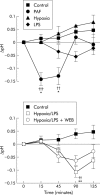The role of platelet activating factor in a neonatal piglet model of necrotising enterocolitis
- PMID: 14724152
- PMCID: PMC1774938
- DOI: 10.1136/gut.2003.024521
The role of platelet activating factor in a neonatal piglet model of necrotising enterocolitis
Abstract
Background and aims: Necrotising enterocolitis (NEC) is a potentially devastating disorder of preterm infants but its aetiology remains unclear. The aim of these studies was to develop a neonatal piglet model for NEC and to then use the model to investigate the role of platelet activating factor (PAF) in its pathogenesis.
Methods: Anaesthetised newborn piglets were divided into six groups: (i) controls, and groups subjected to (ii) hypoxia, (iii) lipopolysaccharide (LPS), (iv) hypoxia+LPS, (v) hypoxia+LPS and the PAF antagonist WEB 2170, and (vi) PAF. Arterial blood pressure (ABP), superior mesenteric artery blood flow (MBF), mesenteric vascular conductance (MVC), and arterial blood gases were recorded, and intestinal histology was evaluated.
Results: Exposure to LPS, hypoxia+LPS, or PAF all caused haemorrhagic intestinal lesions associated with varying degrees of intestinal injury. PAF caused a significant initial decrease in both MVC and MBF whereas hypoxia+LPS caused a significant late reduction in ABP and MBF with a trend towards a decrease in MVC. The effects of hypoxia+LPS on both haemodynamic changes and intestinal injury were ameliorated by WEB 2170.
Conclusions: Administration of hypoxia and LPS or of PAF in the neonatal piglet induces haemodynamic changes and intestinal lesions that are consistent with NEC. These effects are ameliorated by prior administration of WEB 2170, indicating an important role for PAF in the pathogenesis of NEC.
Figures


References
-
- Kliegman R, Fanaroff A. Necrotising enterocolitis. N Engl J Med 1984;310:1093–103. - PubMed
-
- Brown EG, Sweet AY. Neonatal necrotising enterocolitis. Pediatr Clin North Am 1982;29:1149–70. - PubMed
-
- Uauy R, Fanaroff AA, Korones S, et al. Necotizing enterocolitis in very low birthweight infants: Biodemographic and clinical correlates. J Pediatr 1991;119:630–8. - PubMed
MeSH terms
Substances
LinkOut - more resources
Full Text Sources
